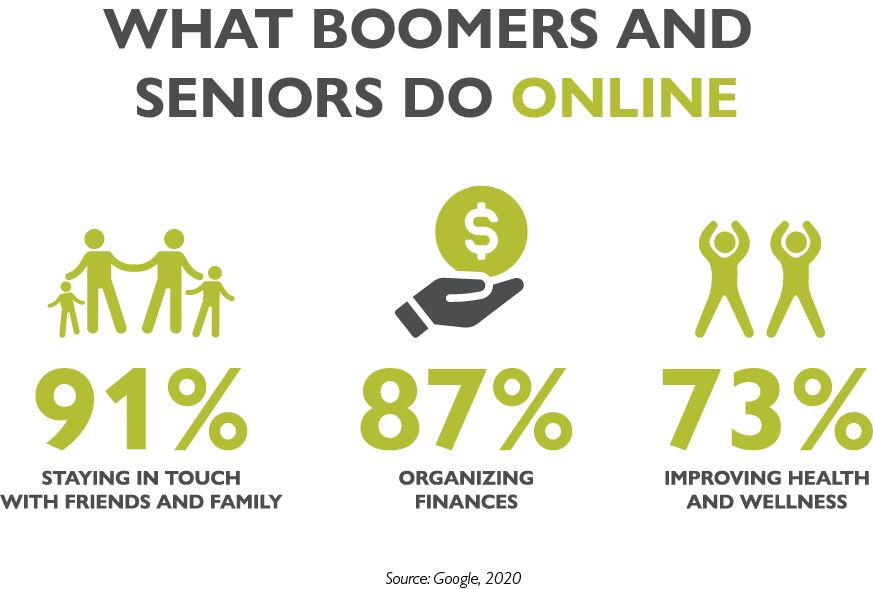Trying to reach baby boomers and seniors online? Here’s the latest look at how 50+ adults use the internet — and how you can use this data to improve your marketing strategies.
1. Internet usage among seniors
In the most recent survey available, Pew Research Center found 87% of adults ages 50 to 64 are online, compared with 82% of those ages 65 to 69 and 75% of those ages 70–74, with those ages 80+ at 44%.
In addition, adoption of key technologies continues to grow, narrowing the gap between 50+ adults and their younger cohorts.

Keep in mind, too, that past research has shown that the 80+ segment within the 65+ cohort tends to bring down the overall average — meaning that isolating those ages 65–74 would likely result in a much higher overall percentage. The bottom line: Digital strategies are a must.
2. How do seniors use the internet?
Most online seniors — 86%, according to Google — are enthusiasts who spend at least six hours a day online and own an average of five devices. Of these “digital seniors,” 82% use their smartphone every day. Most of this digital engagement is drawing from hours spent watching TV. Global media measurement and analytics company Comscore reports that time spent watching YouTube videos among adults 55+ grew by 10% from May 2020 to May 2021.

In Creating Results’ independent research, we found that 88% of those ages 55+ use YouTube on a weekly basis. Don’t get caught in the mindset that online videos and social media only appeal to Millennials and gen Z!

Speaking of social media, Facebook is the most popular social media for mature customers, with 60% of adults 55+ reporting that they use it at least once a day, making it a top channel for marketers. Perhaps the biggest surprise among the latest data: the sharpest increase in Facebook users is among adults ages 78+, increasing from 26% in 2018 to 37% in 2019, says Pew Research. In the same time frame, usage among Millennials and Boomers increased only slightly, and usage among Gen X actually declined.
Close to 20% of adults 55+ report using Instagram and Twitter daily, and TikTok and Snapchat have even entered the conversation. Interestingly, men are more likely to use Twitter, LinkedIn, TikTok and Snapchat than women.
Ensure your social media strategy aims to enhance their experience with posts that inspire and educate — not just sell.

3. How do seniors look for information about a community?
When it comes to searching for information about a 55+ or senior living community, seniors are likely to turn to the internet first.

For marketers, this information means that it’s vital to understand how your digital properties fare from an SEO perspective (read: does your community come up when seniors search common terms?) as well as what information about your community exists on other websites and how accurately online reviews reflect your community’s brand and messaging. A strategy for managing your community’s online reputation has never been more important.
Key marketing takeaways:
- Ensure you’re understanding your audience with the latest consumer insights data rather than stereotypes or outdated information.
- Spend your time and money where your 50+ prospects spend theirs. Facebook and YouTube are among the top digital tactics to consider.
- Prioritize the segment of your audience most likely to convert — we can help.
The prevailing attitude of older adults is that the web is a useful tool. They’re ready to engage online — are you?



